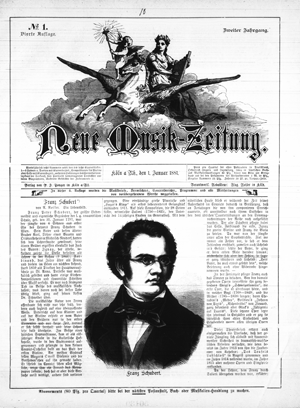Neue Musik-Zeitung
RIPM Preservation Series: European and North American Music Periodicals (2021)
 Publisher: P. J. Tonger (1880-1887); Carl Grüninger (1888-1928)
Publisher: P. J. Tonger (1880-1887); Carl Grüninger (1888-1928)Editors: H. Alexander (1880), August Reiser (1880-1890), A. Svoboda (1890-1901), Ernst Ege (1901-1903), Oswald Kühn (1903-1915), Willibald Nagel (1916-1922), Hugo Holle (1922-25), Hermann Ensslin (1926-1927), Alfred Burgatz (1928).
Periodicity: Bi-monthly (1880-1903), Fortnightly (1904-1922), Bi-monthly (1923-1928)
Published by Peter Josef Tonger (1845–1917) in Cologne, the earliest issues of the Neue Musik-Zeitung were anchored by short musical compositions, typically two pages in length for either solo piano or voice and piano, appearing on pages 2 and 3 of each issue. In these early issues, much textual attention was paid to matters of pedagogy, music theory, and musical notation. Beginning in the second year, printed music appeared as independent supplements (Beilagen) in order to separate the notated music from the text. In addition, advertisements and the occasional catalogue can be found as supplements.
It was not until 15 September 1882 (vol. 3, no. 18) that the editor provided a prospectus for the Neue Musik-Zeitung. He explains that the Neue Musik-Zeitung would attempt to, “... marry music, the effective link in the chain of means for higher moral development, more and more with the life of the people; we will try to lead the cause of the inner man against the onslaught of the outside world and to strengthen the sense for the beautiful, the feeling for the noble.”
In 1888, the journal passed to the Stuttgart-based music publisher Carl Grüninger. Under Grüninger, supplements became standardized with a corresponding musical work appearing with each issue; in addition, textual supplements—containing musical and literary columns, feuilletons, and advertising—regularly appeared. The journal published copious biographical portraits, often accompanied by a photograph, of musicians in the German-speaking lands, in addition to musical news and correspondence. Following Ernst Klett and Julius Hartmann’s acquisition of Grüninger in 1897, the journal maintained its format until 1904 when it was reduced in size from three columns to two but began publishing contributions from more significant writers on contemporary composers, new publications, and musical research.
Following a conservative period after the conclusion of the first World War, in 1924 the journal’s format changed to closely resemble Die Musik, the larger and well-known journal then published by the Deutsche Verlags-Anstalt, also in Stuttgart. The Neue Musik-Zeitung’s content in this period mirrors that of its larger sibling but in shorter format contributions. The journal ultimately merged into Die Musik formally in 1928.
